The history and life of Ernesto Guevara de la Serna, known as "the Che", is inextricably linked to that of Bolivia. Just the last months of his life were spent by him in this country in an attempt to export the revolution to other Latin American states and in Bolivia he was captured and killed in La Higuera on 9 October 1967, near Vallegrande where instead the body was exposed and secretly buried. In this area there is now a tourist route on the trail of Che Guevara which takes the name of Ruta del Che.
Che Ruta Tours in Bolivia
Many tourists take part in this tour of Che Guevara in Bolivia. From tourists who are passionate about history and simply curious as we are, to true fanatics who face the Ruta del Che as if it were a sort of religious pilgrimage.
If you want to travel along the Ruta del Che your starting point will probably be Santa Cruz, the largest city near Vallegrande from which it is about 250 km away.
The road from Santa Cruz to Vallegrande and above all to La Higuera is long, unpaved and winding. The journey is not easy and it is obviously used much more than you might think, as we are used to making such journeys usually through straight and paved motorways. But if you have been travelling in Bolivia for some time now, you will be accustomed to these transportation conditions.
How to get to Vallegrande from Santa Cruz
From Santa Cruz, a stage chosen mainly as a base to visit the Ruta del Che, you will first of all have to reach Samaipata. Not far from the center of Santa Cruz, we have reached it on foot, there is a small terminal of mini buses that depart once they are full towards Samaipata. Ask for directions and the exact address in your hostel or hostel, usually they are very well informed because it is from Santa Cruz that the tourists leave to travel the Ruta del Che.
Once you leave with the mini bus (30 bolivianos) you reach Samaipata in about 2? hours. The journey is not the most comfortable, especially if like me you end up in a place invented between the driver and the passenger, riding the horse of the change on a piece of wood?0 The panorama that you can see to reach Samaipata in return is not bad at all.
In Samaipata there is nothing in particular to see but it is very nice and quiet and for this reason, and to break the journey towards Vallegrande, we decided to stay here one night.
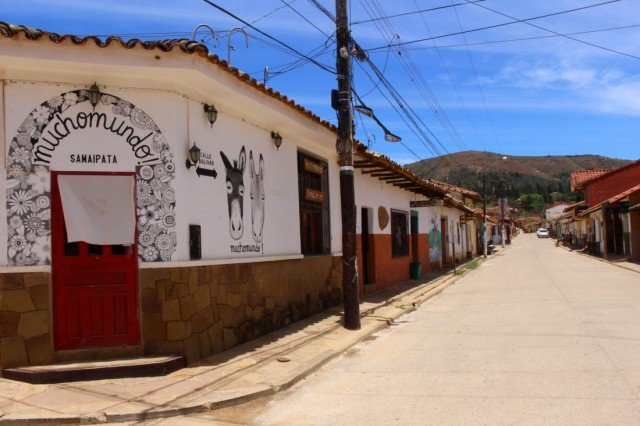
The quiet village of Samaipata
From Samaipata to Vallegrande you will have to break the trip in two, taking a shared taxi to Mairana first (do it in the morning because the frequency decreases during the day). In about half an hour the taxi, which we paid 7 bolivianos per head, will reach Mairana and leave you, if you ask, at the terminal of the mini buses that depart for Vallegrande.
Wait until the mini bus is filled and from Mairana you will reach Vallegrande in a little less than 2 hours at the cost of 30 bolivianos.
Che Guevara a Vallegrande: how the tour works
Vallegrande is a small village with some roads that branch off from the main square where the tourist information office is located and where you will book the tour on the places of Che Guevara in the country.
The tour on the Ruta del Che in Vallegrande must necessarily be done with a guide because the places visited are closed and only the authorized guides can open them. Then book one of the day tours immediately on the same day and start at a predetermined time.
The tour on the Ruta del Che a Vallegrande lasts about 2 hours, costs 40 bolivianos and the guide is only in Spanish, but don't worry: the information is quite basic and you won't have problems to understand the whole thing.
The tour is normally meant to be on foot, it's a few kilometers, but if you want to do it by car, option that we have chosen us since it was 2 in the afternoon and there were more than 30°, it costs another 15 bolivianos per head.
Ruta del Che: what to visit in Vallegrande?
The first place that the guide will make you visit in Vallegrande is the hospital laundry where Che Guevara's body was exhibited for 2 days in the international press. The place remained as it was in 1967, enriched day after day by the writings of tourists and pilgrims who praise Che, revolution, freedom, etc..
Body laundry That Vallegrande rue of that
The hospital's laundry - which is still open - where the Che's body was exhibited
Laundry hospital laundry Vallegrande ruta of the that
The second stage is a small cemetery where Che's guerrilla companions who were captured with him were buried. The bodies have now returned to the families and the place remains as a remembrance.
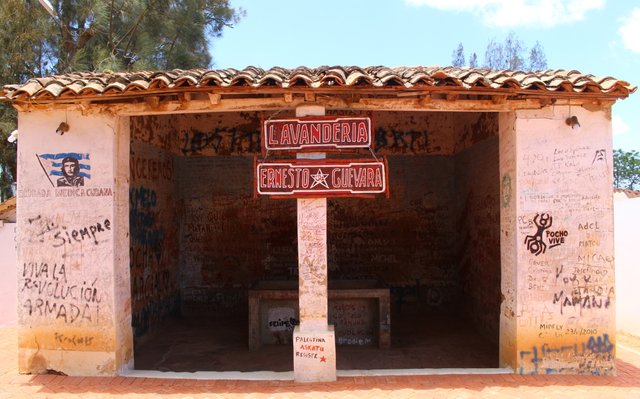
The third and final stage is now a mausoleum with photos of Che Che exposed and used for various events. On the day of our visit, Cuban doctors were rewarded for their work in Bolivia. The mausoleum is important because it is the former military airport and burial place of Che Guevara.
When Che Guevara was killed in 1967, the Bolivian authorities decided to secretly bury him and his companions in a mass grave where the military airport stood. This is because it was not wanted that the burial place could become a place of pilgrimage and to prevent the mythology of the revolutionary attempt in Bolivia.
In 1997 a former soldier confessed the long kept secret of the Bolivian authorities and so Che Guevara was transported to Cuba and buried in Santa Clara.
Inside the Mausoleum is still dug a large pit with inside the commemorative tombstones of Che and his companions who were found buried there. Here you can also visit a small museum with memories, photographs and memorabilia of guerrilla warfare and Che Guevara.
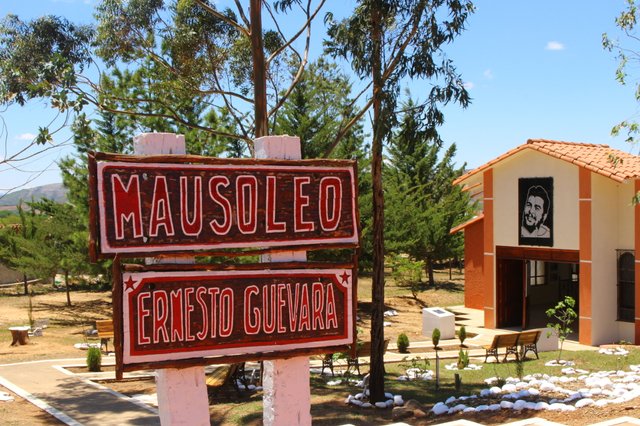
place burial Che Guevara Vallegrande
Che mausoleum and former military airport where the commander was secretly buried for 30 years
Ruta del Che: from Vallegrande to La Higuera
Many tourists visit the Ruta del Che only in Vallegrande for reasons of time, but since we had no problems from this point of view we decided to continue to the place of killing of Che.
From Vallegrande to La Higuera it takes about 2 hours of taxi that has cost us 250 bolivianos. We have taken the taxi driver who suggested us the tourist office in the square of Vallegrande, if you find one from you maybe you will be able to save something. If you want you can also take a guide that will accompany you to the visit of La Higuera, but it will cost you at least a hundred more bolivianos.
The Higuera is basically a dirt road and a square, a handful of houses and some hostels.
Here you can visit the Telegrapher's House, now transformed into a charming hostel, a sort of center that is used for more purposes full of murals of Che Guevara, two great monuments in the main square and for 10 bolivianos the old "escuelita" where the Che was held prisoner and killed. Today it is a real memorial full of memorabilia and memories left by tourists.
The Higuera Che's Ruta tour
One of the two monuments in the square of La Higuera
La Higuera Murales ruta del Che
Inner courtyard of the polyvalent centre of La Higuera
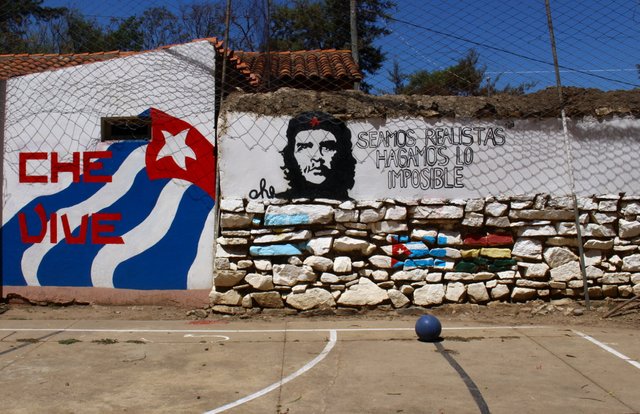
If you've got to stop and chat with the French couple who have been running the post of "Los Amigos" for 15 years, two real fanatics of Commander Che.
The Higuera is a world apart, super quiet, far from all the comforts of modern life, where the mobile phone barely takes pain and is spontaneously wondering how two Europeans (but in the country there are different) can move here and be able to fill their days.
From La Higuera, the last stop of the Ruta del Che sarebbe quebrada del Churo, the exact place in the middle of the wood in which the Che was captured. We have not been there because in reality there is very little to see if not a commemorative stone or something like that, but if you are really super fan of the commander who you can reach her on foot from La Higuera in about an hour's walk.
2017 was a special year for the Ruta del Che che because October 9th was the 50th anniversary of Che Guevara's death. For the occasion, Evo Morales and Bolivia have established a great festival throughout the country, with events, events and meetings that culminated in La Higuera, which was invaded by thousands of tourists and famous personalities as never before seen. Our French friends have hosted Ernesto Che Guevara's brothers and sons several times, not only on this occasion.
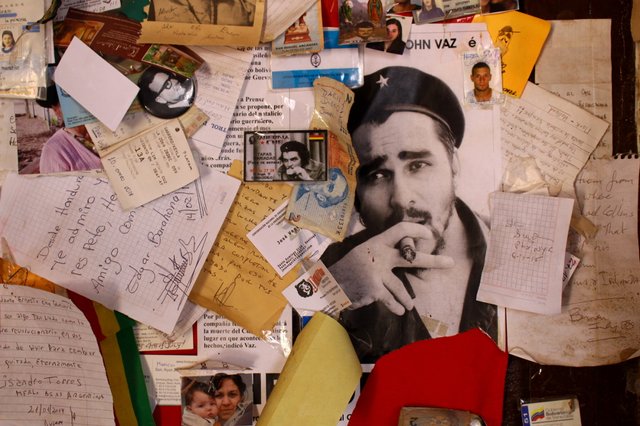
But don't get a wrong idea. The figure of Che Guevara is not celebrated and loved by all, for the anniversary itself there have been demonstrations of dissent and protest against these celebrations. We can say that the Bolivians are almost divided in half between those who see him as a positive figure and those who see him as a negative character.
very nice
Downvoting a post can decrease pending rewards and make it less visible. Common reasons:
Submit